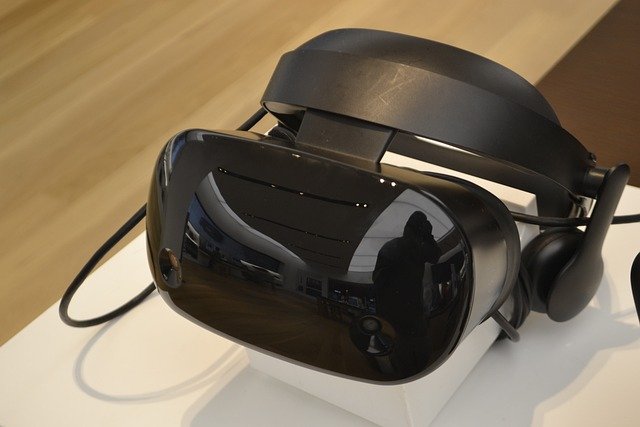Virtual Reality Headsets: A New Era in Entertainment

Table of Contents
In the ever-changing technological landscape, virtual reality (VR) has emerged as a game-changing frontier, expanding the boundaries of entertainment and immersion. This transformational technology, once the domain of speculative fiction, is today a tribute to human ingenuity, providing an escape into previously thought impossible realms. The VR headset, a marvel of modern engineering, serves as a conduit through which the fabric of reality is woven with digital threads, resulting in experiences that are felt rather than seen or heard.
The Evolution of VR Technology

The history of VR technology is a chronicle of human aspiration, ranging from 19th-century panoramic frescoes to today’s sophisticated headsets. Its evolution demonstrates the relentless human pursuit of immersion, a journey marked by innovation milestones that each pushed the bounds of what was previously imagined. With its sophisticated algorithms and cutting-edge hardware, today’s VR technology is the culmination of decades of exploration, refinement, and vision.
Understanding VR Headsets

Virtual reality headsets are the digital age’s alchemists, transforming everyday surroundings into worlds of limitless possibilities. These devices use a symphony of technologies—high-resolution displays, accurate motion tracking, and spatial audio—to create experiences that captivate the senses. They are more than just tools; they are portals to the vast expanse of the virtual, where the rules of physics are rewritten and the physical world’s limitations disappear.
Types of Virtual Reality Headsets

The VR headset ecology is diverse, with every variant catering to the individual needs of the digital explorer. Standalone headsets, free of the constraints of extraneous devices, provide a haven of wireless freedom. Tethered headsets, connected to powerful PCs or consoles, provide unsurpassed visual fidelity and intricacy. Meanwhile, smartphone-based VR headsets offer democratized access to virtual reality, transforming everyday objects into portals to other worlds.
The immersive experience of VR

VR’s fascination stems from its unprecedented ability to immerse the viewer in a virtual tapestry. This immersion is more than visual or auditory; it encompasses all senses, forming a cocoon of experience that transcends the medium’s bounds. In VR, people live the environment rather than view it, engaging with the virtual fabric with a visceral and meaningful presence.
VR Gaming: A New Frontier

The introduction of virtual reality has irreversibly altered the gaming landscape, transforming the passive observer into an active player. VR gaming is a conversation between the user and the virtual world, a dance of interaction that blurs the distinction between the player and the protagonist. In this new frontier, the game is no longer a remote narrative but a personal journey in which every action resonates with the weight of presence.
VR in Movies and Interactive Storytelling

VR adds a new vocabulary to the storytelling language, changing the linear tale into a canvas for exploration. In virtual reality films and experiences, the story is discovered rather than told, enabling the viewer to immerse themselves in the narrative and gaze beyond the frame. This shift in storytelling, from passive consumption to active investigation, represents a paradigm shift in how narratives are created and experienced.
Educational Applications of VR

Beyond entertainment, VR has emerged as a powerful tool for education and training, transforming abstract knowledge into actual experience. From dissecting virtual cadavers to visiting historical civilizations, VR education goes beyond the typical classroom, connecting theoretical knowledge with practical practice. This VR application improves learning outcomes and sparks the curiosity and involvement that are hallmarks of a good education.
Social Interactions in Virtual Spaces
VR redefines the limits of social contact, providing environments in which distance and physicality are irrelevant. Users can form friendships in these virtual gatherings not limited by geography, sharing different and intensely personal experiences. These virtual worlds are not simply duplicates of the physical but rather new realms of interaction in which the language of gesture and presence speaks volumes.
The future of VR headsets

The future of VR technology is brimming with the promise of innovation, from advances in haptic feedback that replicate touch to the unrestrained freedom of wireless communication. The future of VR headsets is in its potential to break down the remaining boundaries between the user and the virtual, creating experiences that are increasingly indistinguishable from reality. As these technologies advance, so will the experiences they provide, ushering in a future in which virtual and real are inexorably linked.
Challenges and Considerations
However, VR technology faces obstacles, ranging from high entry costs to user comfort and health worries. Addressing these difficulties is critical to VR’s future growth, ensuring it stays an accessible and pleasurable experience for everyone. As VR evolves, so must the design and ethical principles that drive its development, ensuring that this powerful technology improves the human experience without sacrificing quality.
Conclusion
Virtual reality headsets represent more than just the next chapter in entertainment; they herald a new era of experience, a revolution in how we interact with the digital world. As we approach the dawn of a new era, the potential of VR is only limited by the scope of human imagination. By accepting this technology, we access realms beyond reality to experiences that enrich, educate, and connect in previously inconceivable ways. The VR age is more than just an evolution of entertainment; it is a change of the human experience, a journey into the limitless potential of the virtual frontier
Join us on this exciting Journey!
At BounceBytes, every byte of information bounces toward a brighter, healthier, and more vibrant you.



